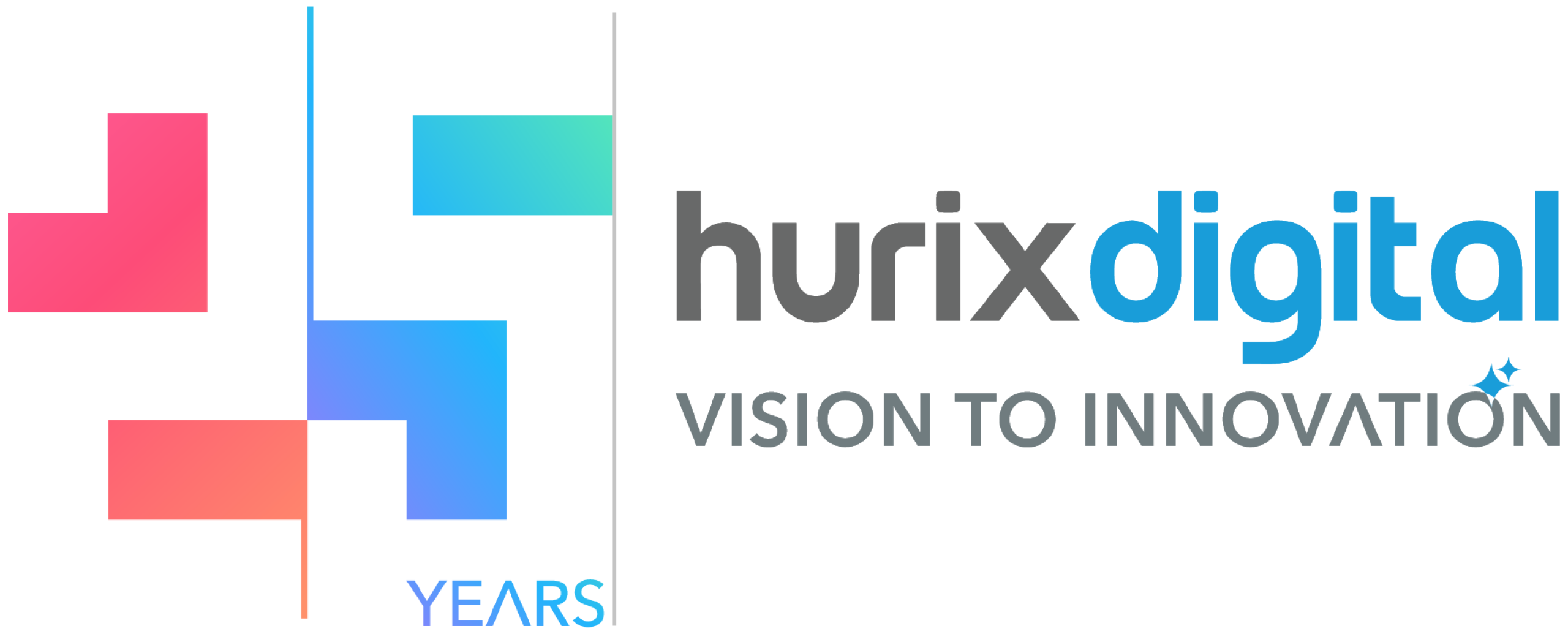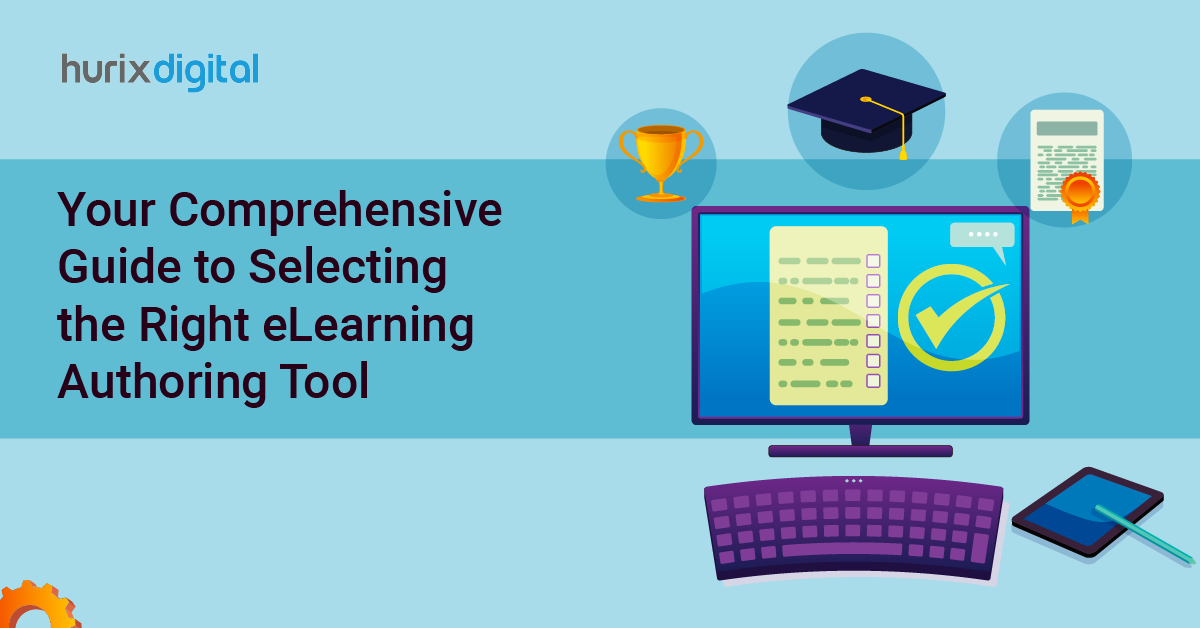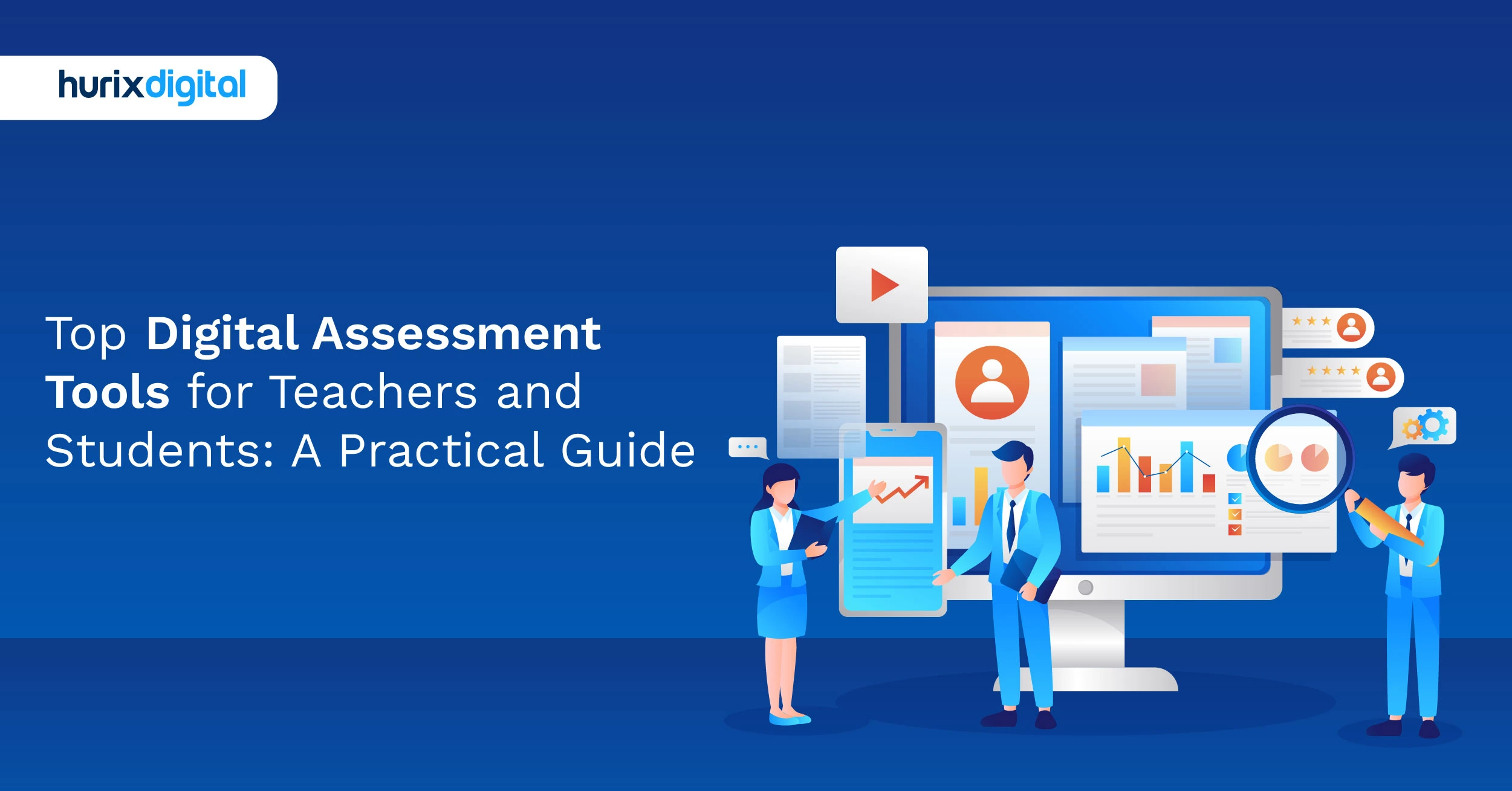
Top Digital Assessment Tools for Teachers and Students: A Practical Guide
Summarize with:
The concept of digital learning wasn’t introduced during the COVID-19 pandemic; it has been around for over a decade, but didn’t get enough attention from all educational institutions.
Online education and learning have had an impressive impact on students and teachers alike. According to McKinsey’s findings, from 2011 to 2021, the number of learners enrolled in online courses increased from 300,000 to 220 million.
However, times have changed, as have trends, since 2020 – students now report that they understand their syllabus concepts better through online learning and prefer eBooks over physical books. Digitalization is not only beneficial for learners but also for educators, as digital assessment tools for teachers and other innovative features make it easy to track student progress and design effective training modules.
This is almost unimaginable in old-school education, as it makes it hard for educators to track how every student in the class performs.
Moreover, in today’s age, educators pay attention to the learning style of the learners because there are four kinds of learners. A visual learner would require diagrams and related graphs to grasp a concept, whereas an auditory learner would require a text-to-speech feature in their learning tool.
For all the aforementioned reasons, digital learning takes the crown, and in this article, we’ll discuss the best digital assessment tools teachers can greatly benefit from.
Table of Contents:
- Understanding Online Assessment Tools
- 3 Ideal Ways to Use Digital Assessment Tools
- Benefits of Online Assessment Tools
- 10 Most Popular Digital Assessment Tools For Students and Teachers
- To Wrap Up
Understanding Online Assessment Tools
Tools for online assessments are a crucial component of education. These resources help teachers assess their students’ development, pinpoint their areas of weakness, and provide prompt feedback.
An effective e-assessment tool could enhance student engagement because assessments are more interesting and stimulating.
From multiple-choice quizzes to complex problem-solving simulations, digital assessment examples showcase the diverse assessment formats available in the digital age.
3 Ideal Ways to Use Digital Assessment Tools
Digital assessment tools fill all the gaps in the education sector by providing top-notch features to educators and learners. Here are three of the best ways to use these tools.
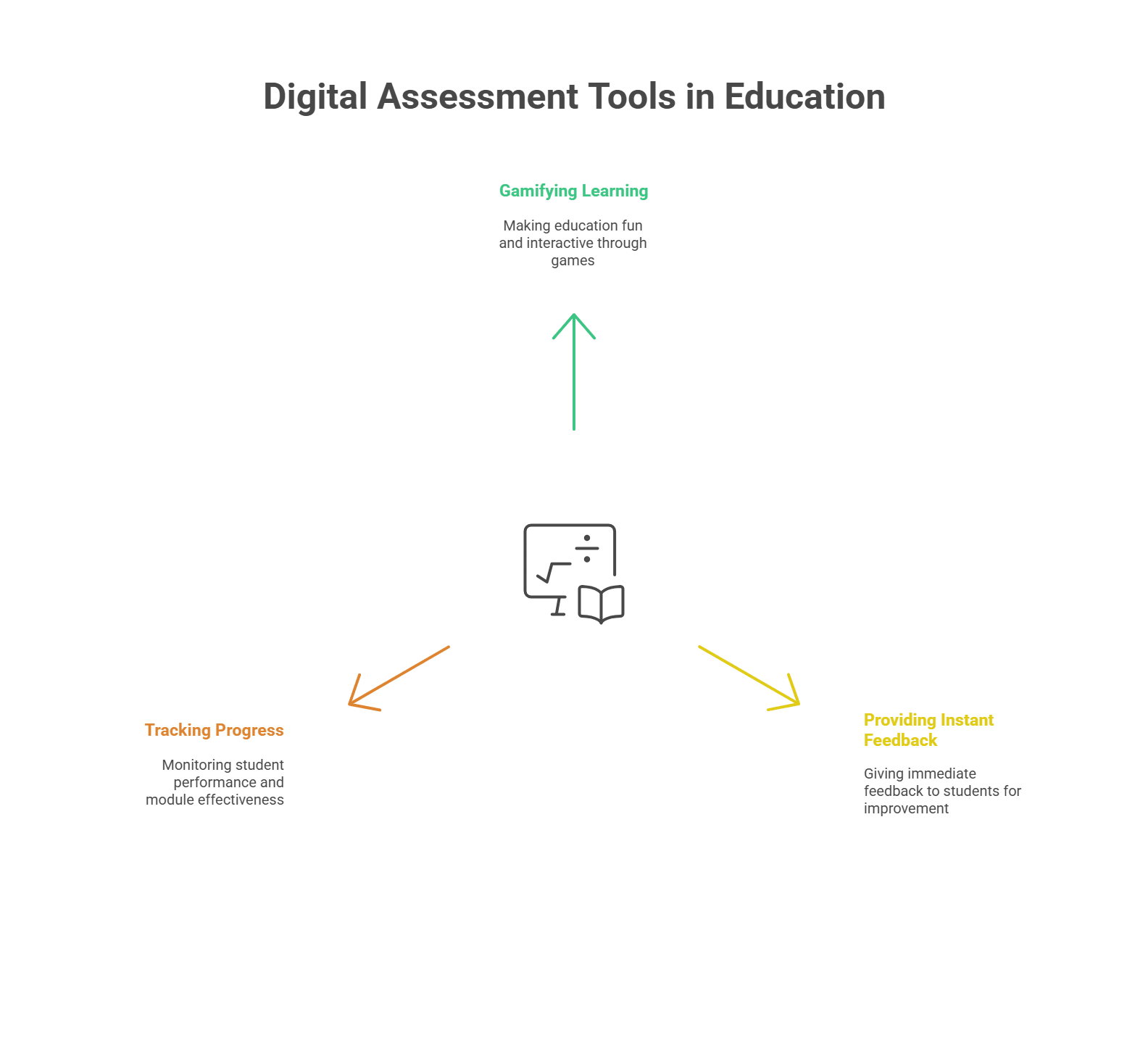
1. Gamifying Learning
Unlike old-school learning, online learning makes every training session fun and interactive for learners.
Hurix, for instance, offers powerful features that support gamification in education and integrate digital assessment tools for teachers, enabling trainers to design creative, out-of-the-box modules. This approach keeps learners motivated and makes lessons more enjoyable. With gamification, trainers can transform course-related questions into interactive games.
The rules are pretty basic: correct answers will allow students to reach a new level and also reward them to keep them committed to learning.
2. Providing Instant Feedback
As previously discussed, it’s not easy for teachers to comment on each student’s performance in old-school learning.
Thankfully, tools like Hurix allow trainers to provide feedback to students instantly after tests and quizzes so that they can understand which areas need improvement.
3. Tracking Progress
Analytical tools are highly important in digital learning as they help educators figure out how students perform and where they can improve.
Moreover, if a module isn’t working well, educators can easily modify it based on the information they receive by tracking the student’s progress.
Benefits of Online Assessment Tools
Here are the key benefits of online tools for assessment to gain a deeper understanding of their value:
- Digital Learning Environment:The shift to digital assessment tools for teachers has created an efficient learning-teaching ecosystem. Educators can use eLearning portals to share engaging content with students, conduct regular quizzes, and administer online tests seamlessly.
- Enhanced Transparency: These tools allow educators to establish clear exam guidelines and parameters upfront. Educators have complete control over the online assessment process, from setting time limits and point allocations to incorporating features like negative marking and bonus points.
- Flexibility and Accessibility: Online assessments are intrinsically flexible. Students’ access to examinations is flexible because they can take them from wherever they wish at their own convenience, which would be helpful for students whose venues are geographically scattered or for those with disabilities.
- Interactive Formats for Assessments:The days of traditional pen-and-paper testing are long gone. Modern digital assessment tools for teachers include multimedia elements such as images, audio, and video, making evaluations more interactive and improving student engagement.
- Proctored and Secure: Online assessment tools come with built-in proctoring capabilities to ensure academic integrity. Moreover, they offer a detailed report stating the performance of educators’ question-by-question analysis of students.
- Grading Streamline with Research Analysis: These tools could automate grading and save many educators’ precious hours of work. They also have AI-powered analytics that tell much about educational developers, strengths, and weaknesses among student,s so that teaching strategies can be crafted by the educationist himself to improve learning outcomes.
- Integration with Other Systems:The best digital assessment tools for teachers integrate smoothly with other educational technologies such as Learning Management Systems (LMS) and Student Information Systems (SIS). This centralized data management makes it easy to store, retrieve, and utilize academic information efficiently.
10 Most Popular Digital Assessment Tools For Students and Teachers
Digital assessment tools provide more flexibility, customization, and immediate feedback.
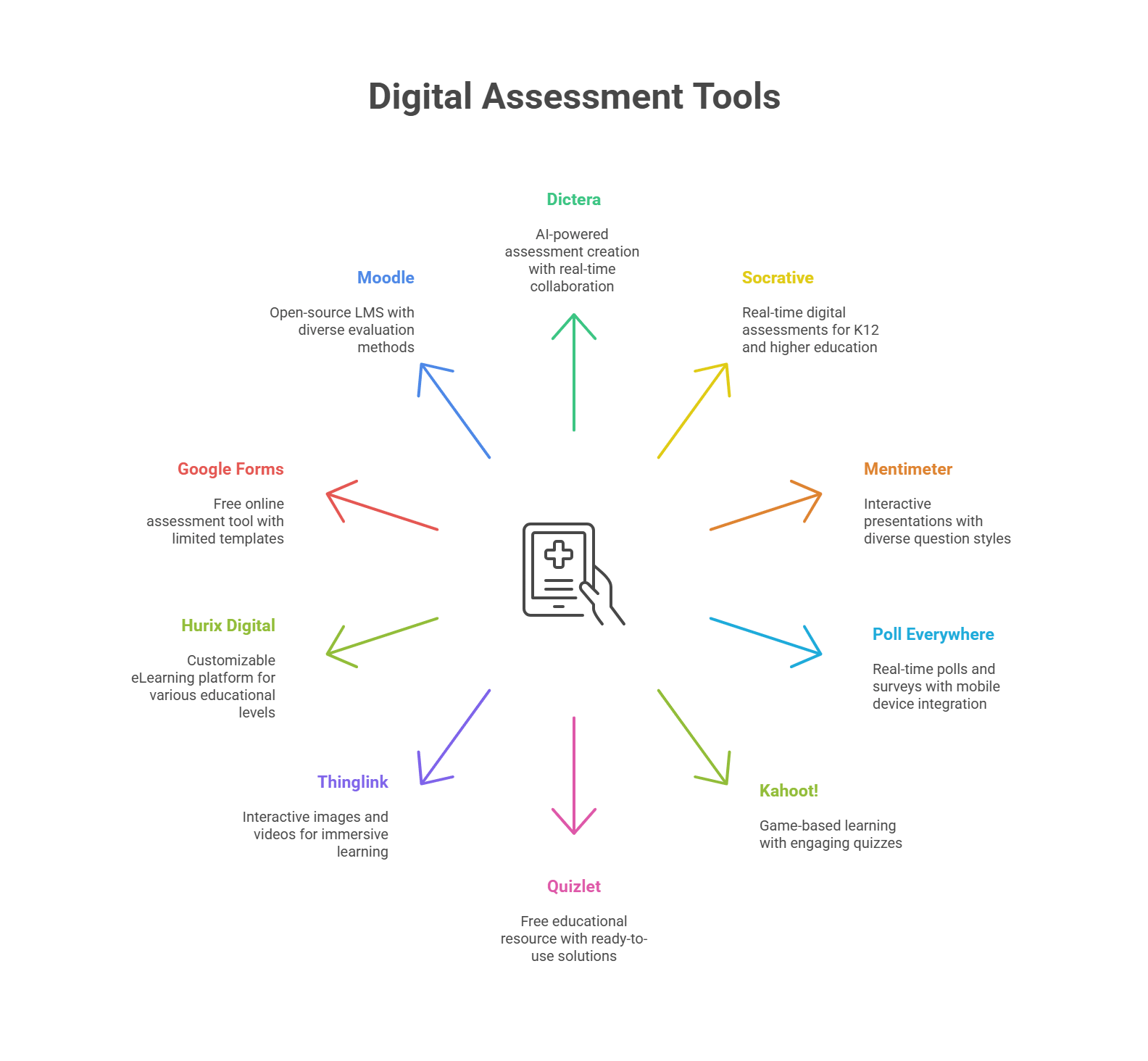
Here is a list of digital assessment tools that you can consider to improve your students’ learning experience:
1. Dictera
Dictera by Hurix Digital is a cutting-edge digital assessment platform that enables educators to streamline their workflow and create excellent assessments easily.
Leveraging the power of AI/ML to automate the creation of assessments, saving you time and effort, Dictera provides an intuitive interface coupled with real-time collaboration, allowing seamless work integration to define roles, assign tasks, or track the process.
Dictera’s sophisticated analytics provide information about the success of your team members, enabling you to make wise choices. Workflows are streamlined by automating repetitive tasks, allowing you to focus on developing interesting and useful evaluations.
2. Socrative
Socrative is one of the most popular digital assessment tools for teachers, designed to create and administer assessments in real time.
Primarily used in higher education and K–12 classrooms, it offers multiple-choice, true/false, and short-response question formats. One of its standout features is its analytical reporting, which allows teachers to monitor student performance, track growth, and adjust teaching strategies accordingly.
3. Mentimeter
Mentimeter is an interactive presentation tool for teachers to conduct creative evaluations. The platform offers a wide variety of question styles, including multiple-choice, true-false, and open-ended. The tool’s real-time analytics and reporting capabilities allow teachers to monitor their pupils’ progress and grades.
4. Poll Everywhere
This online tool allows users to create polls, quizzes, and surveys in real time. In the classroom, they are very much present. It allows a wide variety of question kinds, including rating scale, open-ended, and multiple-choice questions.
Students can answer polls using laptops, tablets, or mobile devices, and the results are displayed on the teacher’s screen immediately. It works with a variety of learning management systems and presentations, such as PowerPoint and Google Slides.
5. Kahoot!
Kahoot! is a game-based learning tool for educators and learners, as the name implies. Among other question types, it enables teachers to create engaging assessments and quizzes with multiple-choice, true-or-false, and open-ended questions. Game-based learning activities help students learn and retain material engagingly and fascinatingly.
6. Quizlet
A free educational resource called Quizlet aims to make learning interesting and fun. Its collection of assessment and evaluation tools allows teachers to create engaging and dynamic assessments for their students.
The platform’s best feature is its section of ready-to-use Quizlet Solutions for popular textbooks, which enables students to learn more about a certain subject.
7. Thinglink
Thinglink permits educators to produce interactive images and videos within their lessons. It contains a plethora of audio, video, text, and other media that can be integrated into an image or a video.
Thinglink encourages teachers to create interactive timelines, maps, infographics, and much more for their students’ learning experience. Students can interact with these images and videos by clicking on the embedded links, which lead to further content or activities.
8. Hurix Digital
Hurix Digital is one of the most useful platforms for digital learning. With over 20 years of experience, Hurix Digital makes eLearning easy and fun for trainers and trainees.
This platform can be used for K12 education, higher education, and corporate training. It’s highly customizable and encourages game-based learning that includes problem-solving, puzzles, situational judgment scenarios, quizzes, etc., so learners can improve their creative and problem-solving abilities.
Plus, Hurix Digital is suitable for all kinds of devices, including smartphones, so learners can continue learning even while on the go.
9. Google Forms
If your institution primarily uses the Google ecosystem, Google Forms is a completely free option. This simple and intuitive tool allows teachers to create and deliver assessments online. The platform offers various question types, including multiple-choice, true-or-false, and open-ended questions.
Google Forms also provides real-time analytics and reporting features that allow teachers to track student progress and performance. The only downside is that the tool has limited templates, especially for education. So, creating an assessment requires a lot of manual effort.
10. Moodle
The open-source learning management system (LMS) Moodle offers a framework for developing and delivering online courses.
Teachers can use a range of evaluation methods, such as seminars, assignments, and quizzes, to evaluate their students’ performance. The platform also accepts a range of question types, including multiple-choice, essay, and true/false questions.
To Wrap Up
While students in a physical classroom are usually assessed through periodic tests, spot questions, and quizzes, digital assessment tools for teachers take evaluation to the next level. They provide continuous assessment by tracking students’ creative thinking, learning abilities, and overall test performance. The feedback generated is more detailed and actionable, enabling students to identify gaps and improve their performance effectively.
Choosing the right digital assessment tool for teachers can transform the learning experience. Platforms like Hurix are highly suited for effective online learning. Their advanced assessment tools help educators bridge course gaps, personalize instruction, and deliver a world-class education to students.
Check out Hurix Digital and redefine eLearning today with top assessment tools.
Summarize with:

Senior Vice President – Business Development
at Hurix Digital, with over 25 years of experience in EdTech and workforce learning. He excels in business development, customer relationship management, and scaling digital learning solutions, driving global growth through innovative content, simulations, and AI‑driven training offerings
 A Space for Thoughtful
A Space for Thoughtful 